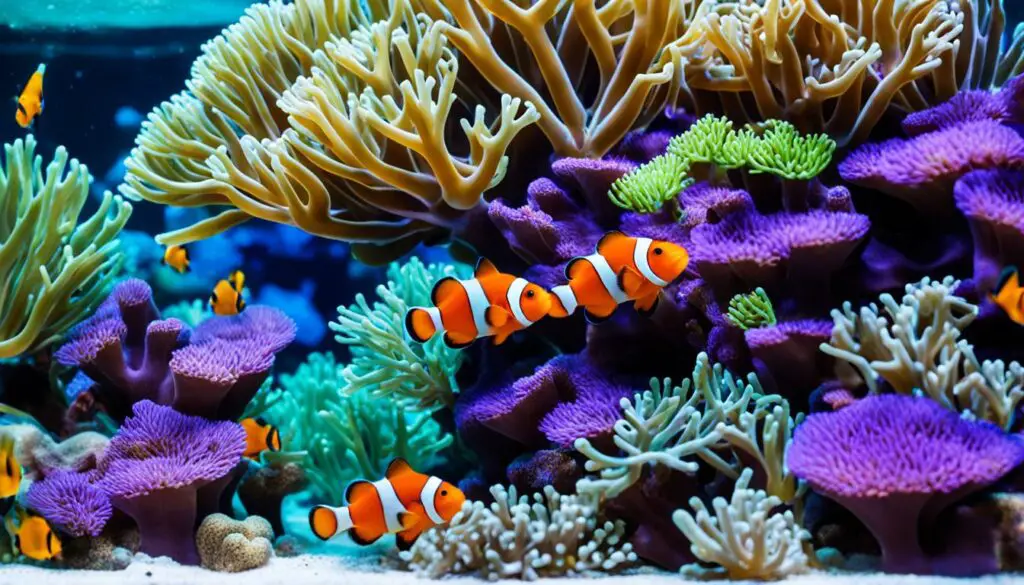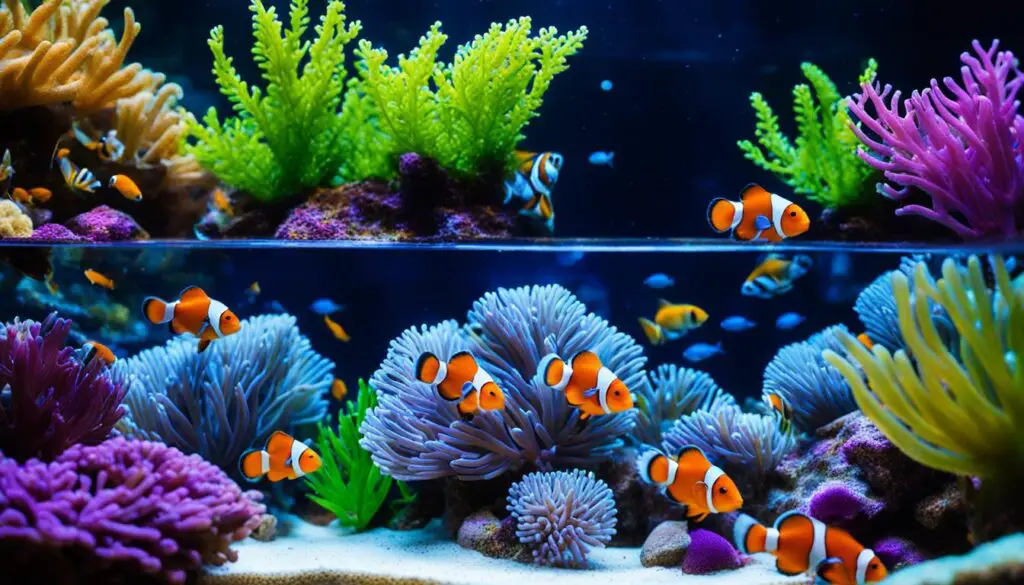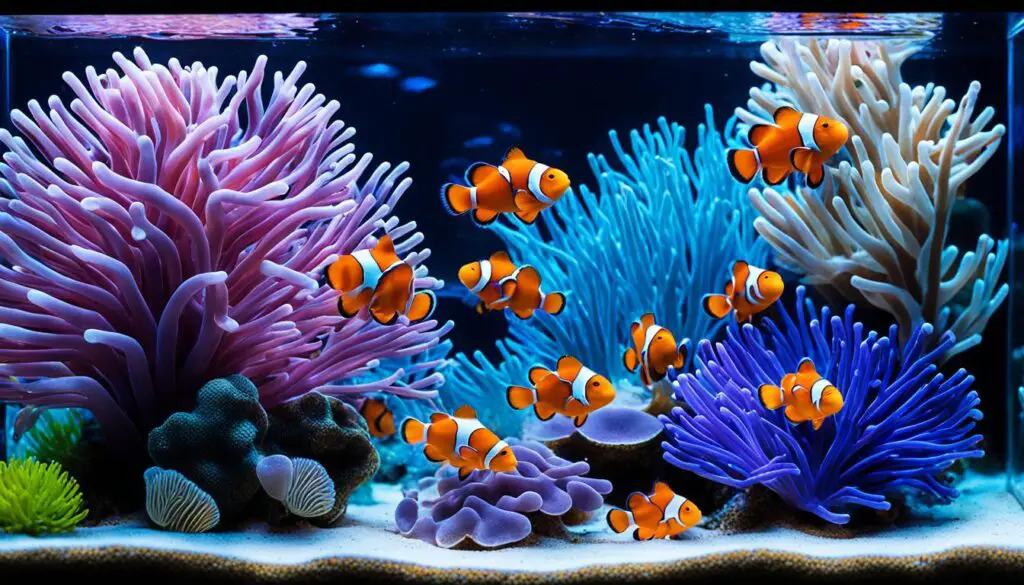Observing Clownfish Behavior: The Ultimate Guide
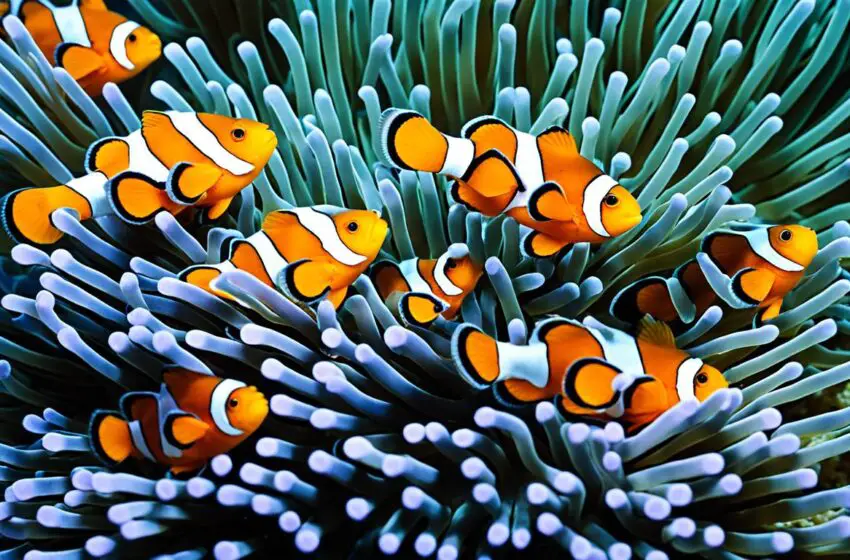
Clownfish and their interactions with other fish are very interesting. In this ultimate guide, we will explore how clownfish get along with other fish. You’ll learn how to make your fish tank a happy place for all your fish.
We’ve gathered facts from reliable sources for this guide. We talk about how to breed clownfish and get them used to their tank mates. This guide is for everyone, from beginners to those who have been keeping fish for a while. It will give you tips and advice to enjoy and support your clownfish’s actions.
Key Takeaways:
- Knowing about clownfish behavior makes your fish tank more interesting.
- Making sure clownfish get along with others is key to a peaceful tank.
- Feeding clownfish larvae with rotifers is a must for breeding success.
- There are special ways to introduce clownfish to each other to help them bond.
- Watching how they act can teach you a lot about their relationships.
Culturing Rotifers: A Vital Step for Clownfish Larvae
Culturing rotifers is key to raising clownfish larvae well. These tiny creatures from water are rich live food for the baby fish. Culturing rotifers not only gives the needed food but also acts like how they feed in nature. With a strong rotifer culture, your clownfish babies will be healthy and grow well.
Rotifers are simple to grow and you can have a lot in one place, which is perfect for clownfish. Getting into rotifer culture, gather these things:
- Live rotifers: Begin with a good number of live rotifers, found at good shops or local water stores.
- Rotifer food and enrichment: For them to be healthy and grow, feed them right. Use foods made just for them.
- Filters for waste export: These keep the water clean by taking out extra stuff that rotifers produce.
- Sieve for harvesting: You’ll need a fine sieve to get the rotifers out from the water they live in.
Starting a rotifer culture is one thing, but keeping it going well needs work. Make sure to feed them right, watch them every day, and get the rotifers out for feeding regularly:
- Feeding rotifers: Giving them the right food is vital. Stick to the advice on how often and how much to feed them.
- Observations: You have to check on them daily. Watch for smells or colors that seem off, or too much stuff in the water.
- Harvesting: Taking them out often means you’ll have enough for the clownfish. Use a sieve to pick them out and feed them to your fish babies.
Cultured rotifers offer more for the fish tank hobby. They help keep corals and other water dwellers healthy as food. Plus, they can live in one place and make a lot more food for water life.
Learning to culture rotifers well means you’re helping the clownfish at a critical time. You make sure they have enough to eat as they grow.
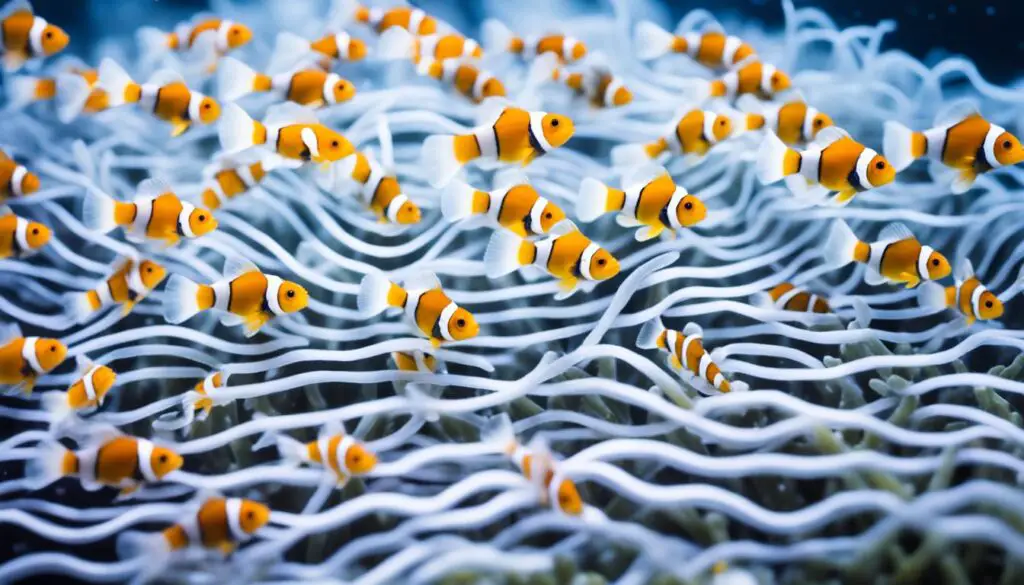
Pairing Clownfish: Techniques and Considerations
Pairing clownfish is not just fun; it’s a process that needs careful thought. There are proven ways to help your clownfish form pair bonds. The well-known methods are the grow out technique and adding a new clownfish to an old one.
The Grow Out Technique
The grow out method is about adding two young clownfish at the same time. They learn their roles over time, leading to a strong bond. Make sure the tank has enough places to hide and claim as their own. Watch how they act to see if they’re becoming friends.
Introducing a New Clownfish to an Existing One
Introducing a new clownfish to one already in your tank can be harder. You need to clean the tank well and mix up the old clownfish’s spots to avoid fights. Always watch how they react to each other and step in fast if they fight. Being patient and slowly mixing them is vital in this method.
Unique Considerations for Maroon Clownfish
Maroon clownfish are special because they can be aggressive. They might need a different start to their friendship. You might have to use a clear barrier to keep them from hurting each other at first. This helps them get used to being around without fighting.
It’s important to see if one of the fish is willing to let the other be boss. Signs like letting the other eat first and staying close can show this. When they’re really a pair, they’ll do things together like guard their spot and flirt.
When trying to pair your clownfish, remember to be patient and watch closely. Use the right methods for your fish and things should go smoothly.
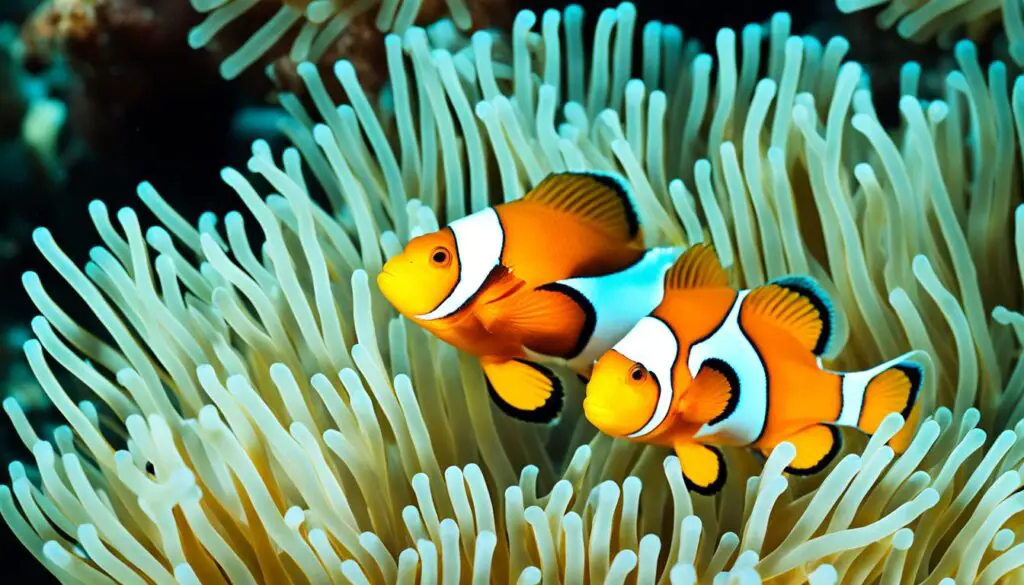
| Technique | Advantages | Challenges |
|---|---|---|
| Grow Out Technique | – Allows natural pair bond formation – Establishes hierarchy | – Requires patience – Needs adequate hiding spots and territory |
| Introducing a New Clownfish | – Increases clownfish population – Can result in successful pairing | – Existing clownfish aggression – Risk of territorial conflicts |
| Unique Considerations for Maroon Clownfish | – Separation technique minimizes aggression – Enables gradual introduction | – Aggressive and territorial nature – Potential need for longer acclimation period |
Conclusion
It’s crucial to understand how clownfish behave with other fish in a tank. This knowledge helps you build a peaceful home for your fish. By choosing the right tank mates, your clownfish and their friends will be happy.
Culturing rotifers is an important part of breeding clownfish successfully. Rotifers are small, but they’re packed with nutrition for baby clownfish. With a good culture of rotifers, your clownfish will have a great start in life.
When trying to make clownfish pairs, use methods like introducing fish or growing them together. Watch for signs that they’re working well together. This approach can lead to a happy group in your tank.
This guide gives you the info you need for a great aquarium with clownfish. It’s about making sure they get along, eat well, and form bonds. By doing this, your fish will feel at home and thrive.
FAQ
What is the behavior of clownfish?
Clownfish are fun to watch. They have a special friendship with anemones. You’ll see them dart, hover, and bob. They’re also about setting up their own space and pecking order.
How can I create a harmonious aquarium for my clownfish and their tank mates?
Keep the peace by choosing tank mates that are a good fit. Make sure they match in size and get along. Stay away from fish that like to pick fights. Also, make sure there are enough places to hide and claim. Finally, care for the water well and keep things clean.
Why is culturing rotifers important for successful breeding of clownfish larvae?
Rotifers are a key snack for baby clownfish. They need top-notch food. These tiny creatures are easy to grow in big numbers. This means a lot of food for the little fish.
What equipment do I need to culture rotifers?
For rotifers, you’ll need live ones, special food, and filters for cleaning. Don’t forget a sieve for sorting them out. Make sure to feed them well, watch them every day, and pick them right.
What are the pairing techniques for clownfish?
Pairing clownfish has a few tricks.
One way is putting two small ones together early. They figure out who’s boss and become friends.
Another way is adding a new clownfish to a bigger one’s home. This method is harder and not always safe for the new fish.
Are there any unique considerations for pairing maroon clownfish?
Maroon clownfish can be bullies. When pairing them, watch closely and prepare with special steps to avoid fights.
Make sure they have plenty of spots to get away and have their own space.
How can I ensure the compatibility of clownfish tank mates?
Look for signs of good friendship to be sure they’ll get along.
Watching how they interact tells a lot. Step in if needed to keep the peace. Regular checking and some help can make your tank a happy place.
How can I create a thriving and harmonious aquarium for my clownfish?
First things first, learn about your clownfish and who they can live with. Feeding them right from the start with rotifers is key.
Use the best methods for making friends between them. With the right care, your aquarium can be a great home for them.

